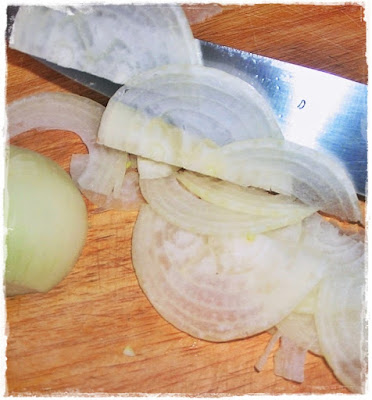A while ago I wrote about how important it is to learn
to cook for all sorts of good reasons; not least that once you can cook you can
eat exactly what you fancy whenever
you like.
I hope these “commandments” will help …
12 Important Cooking Commandments ...
1. Learn to use a knife.
Get a good sized chef’s knife, 8”
is just about perfect. I very much
favour the kind of knife known as Santoku but the traditional shape may work
better for you. Once you are adept at using it prep time will really speed up.
Here's a useful video on how to handle a cook's knife.
With enough practice (say 30 years) you will able, like me, to slice onions like this without looking!
Whilst on the subject; do keep
your knives sharp because they are safer that way! It may seem a strange thing to say but with a
sharp knife little pressure is needed and there is much less risk of the knife
slipping. Furthermore good knife skills
removes the need for all sorts of kitchen gadgets and knick knacks, many of
which are more than adequately replaced by said sharp knives.
2. Use Real Food if humanly possible (which, of course, it is)!
Use fresh fruit and vegetables (except, perhaps, peas which are actually great from frozen) whenever possible and
certainly not tinned green veg, fruit, mushrooms or potatoes. Tinned beans such
as chickpeas, kidney beans etc. are fine and so are tomatoes although I prefer
these in a tetrapack or whatever it’s called as I don’t fancy the thought of
acidy tomatoes reacting with the lining of the can. That’s not a commandment,
however, just a thought.
Avoid processed stuff such as the American
sliced “cheese” that goes on burgers, use butter rather than margarine, make your own salad dressing,
don’t compromise on quality.
3. Read and understand a recipe BEFORE you start cooking it.
I haven’t got much else to say
about this – just do it!
4. Know your weights and measures.
Recipes may well be written using
metric or imperial measurements or the American cup system. If you are not familiar with the scale used
then avail yourself of Google and look it up before you start or there are
several useful links under the appropriately named Conversion Charts and Help in the side bar. Maybe print off
a set of conversion charts and keep them in the kitchen.
5. Prepare everything possible in advance.
This is known in the trade as "mise en place" which is actually French for establishment. To us cheffy types this means
having ready and easily to hand all the ingredients, ready prepared, that are
needed to cook whatever is planned. This includes cut, sliced, chopped veggies,
trimmed pieces of meat, ground spices, washed and chopped herbs, weighed and
measured items and so on. This then
enables you to cook quickly and smoothly once started, without interruption.
6. Always rest meats before serving.
By this I mean roast, grilled and pan fried meats, not so much stews (although they do benefit from cooking several hours or even a day or two before serving so that the flavours can merge and develop). The reason for resting meat is that while resting the meat relaxes, becomes more tender and any juices that have fled to
the middle of the meat to escape the harsh heat flow back into the relaxed
protein and make it juicier. Rest roasts
for up to half an hour (in a warm-ish place,loosely covered with foil), steaks and chops for 5
minutes or so in a warm place.
7 . Waste nothing.
This is very close to my heart. Even the smallest leftover, scrap or trimming
can usually be turned into a garnish or cook’s treat or perhaps added to a
freezer collection.
I love cooking with leftovers, if I have a
bit of that, a tad of that and a smidgen of wotsit I can usually come up with
something worth eating – actually that is why I started this blog. I've even written a book about it ~ Creative Ways to Use Up Leftovers: An Inspiring A – Z of Ingredients and Delicious Ideas.
8. Experiment ~ don’t be afraid of flavour.
At dinner with friends recently I
was surprised and impressed to see our host, Tony, divide his coleslaw into
seven small portions to each of which he added a little something; lime juice,
hot sauce, a pinch of sugar, lots of black pepper, 2 things I can’t remember and
Malibu rum! Now that’s the way to learn
– respect!
I suggest you do the same or
something similar, the more you cook and eat the more you will learn about what
goes with what – play with your food!
9. Baking is a science – don’t experiment!
Successful baking relies on chemical reaction in the
presence of heat and should not be messed with unless you are very
confident. Stick to recipes here – you
can, of course, play with fillings, toppings and accompaniments.
10. Taste before serving
When at home I just bung my finger in the food and then lick it but in a professional kitchen or when cooking for others that is really, really not the way.
To do the thing properly use a clean spoon each time you taste a dish OR 2 spoons; one for dipping, one for tasting OR drop a little of the food to be tasted onto the back of your hand and then lick it. Then wash your hand.
Adjust the flavour to make you happy; maybe a little more salt or a touch of hot sauce, a pinch of sugar, a grind of black pepper or a squeeze of lemon. Be guided by your palate.
Read lots more here about How to Season to Taste.
Not only is this more pleasing but it
actually stimulates the appetite. It's not necessary to arrange a plate to
look like a Picasso but I am not averse to making sure the prettiest lettuce
leaf is on top, cutting a nice shape or adding a suitable drizzle. Read more about making your food look good here.
12. Clean as you go.
Um, I say
this but, well ... do as I say not as I do!
It is a good idea, especially in a small
kitchen, to clean as you go so as to have a useable and pleasant working
area. I agree with this but, on the
other hand, I tend to bung it all in my large sink and then wash up in the
morning. For me the evening meal marks
the end of the day and the start of relaxation time and I have never, ever
regretted leaving the washing up till morning.












No comments:
Post a Comment